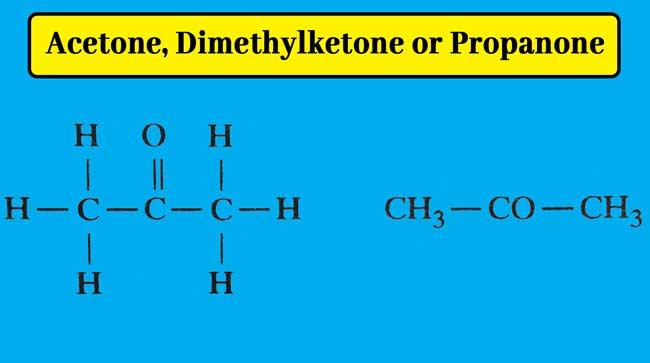How is Ethyl Acetate made? | Properties | Uses
Preparation of Ethyl Acetate
Laboratory Method
In the laboratory, ethyl acetate is made by the action of ethyl alcohol and acetic acid.
CH3COOH + C2H5OH → CH3COOC2H5 + H2O
This reaction is reversible. To prevent the reverse reaction, it is necessary to use a dehydration. Hence this reaction is carried out in the presence of concentrated H2SO4. Concentrated H2SO4 acts as both anhydrous and catalytic.
Method of Use
In a 250 ml round bottom flask, take about 50 ml acetic acid, 50 ml ethanol and 15 ml concentrated H2SO4. Put a direct water condenser in the flask and heat the mixture kept in the flask for about 15 minutes.
After this, the mixture placed in the flask is poured into a distillation flask. Distillation flasks are connected to thermometer, condenser, and receiver. The distillates heat the flask and collect the distilled fluid in the receiver.

The fluid obtained up to 80°C is mainly ethyl acetate. It contains acetic acid, ethyl alcohol, sulfuric acid, water and small amounts of diethyl ether impurities.
Purification
Shaking the impure ester in a separating funnel with a concentrated solution of sodium carbonate. Soluble salts are formed by the reaction of sodium carbonate with acetic acid and sulphurous acid.
These salts fall into the lower aqueous layer in the separating funnel. Open the spout of the funnel and separate the aqueous layer.
- Importance of Biomolecules in Life || What are the 4 main biomolecules?
- Resonance effect or mesomeric effect || What is resonance effect with example?
- Valency of Elements || How to Find Valency || What is the Valency of the atom?
- Glucose Structure: Physical and chemical properties, Glucose Chemical Reaction
- Introduction of Inductive-Effect || How does Inductive Effect Work?
- IUPAC Name : How to find the IUPAC name of compounds.
Calcium chloride is added to the remaining esters. It absorbs ethanol and water and gets deposited in the ester layer.
Filter it or open the funnel and separate it. Distillation of the remaining esters achieves pure ethyl acetate at 77-79°C.
Other Methods
:- Ethyl acetate is also obtained by the reaction of acetic anhydride or acetyl chloride on ethanol.
(CH3CO)2O + C2H5OH → CH3COOC2H5 + CH3COOH
CH3COCl + C2H5OH → CHCOOC2H5 + HCl
:- Ethyl acetate is also obtained by heating the alcohol solution of silver acetate with ethyl iodide.
CH3COOAg + C2H5I →CH3COOC2H5 + AgI
Physical Properties of Ethyl Acetate

Ethyl acetate is a colorless and fruity smelling liquid. Its boiling point is 77°C. It is less soluble in water but is completely blendable(mixture) in alcohol and ether. It is lighter than water and its relative density is 0.91.
Chemical Properties of Ethyl Acetate
Water decomposition: Ethyl acetate is decomposed by dilute acids to form acetic acid and ethanol.
CH3COOC2H5 + H2O → CH3COOH + C2H5OH
Water is decomposed by dilute bases to form acetic acid salts and ethanol.
CH3COOC2H5 + NaOH → CH3COONa + C2H5OH
Oils and fats are esters made with high monocarboxylic acid of glycerol. Their alkaline water decomposition makes soap. Hence the action of water decomposition by the bases of esters is called saponificarion.
Reduction: It is reduced by H2-Ni, sodium ethanol, LiAlH4 or NaBH4 to form ethanol.
CH3COOC2H5 → CH3CH2OH + C2H5OH
Reaction with ammonia: It reacts with ammonia to produce ecetamide.
CH3COOC2H5 + NH3 →CH3CONH2 + C2H5OH
- Coulomb's Law : Electric Field, Potential Difference, Volt
- Gauss Law or Gauss Theorem : Solid Angle and Electric Flux
- Electrolysis : Definition, Principle and Electrolytic Cell
- Adsorption : Adsorption rate, Physisorption and Chemisorption
- Electric Cell : E.M.F., Terminal Potential, Internal Resistance
- How Transistor Works : PNP and NPN Transistors
Reaction with phosphorus pentachloride: It reacts with phosphorus pentachloride to form acetyl chloride and ethyl chloride.
CH3COOC2H5 + PCl5 →CH3COCl + C2H5Cl + POCl3
Claisen’s condensation: Two molecules of ethyl acetate condense in the presence of sodium ethoxide to form ethyl acetoacetate, also known as acetoacetic ester. This reaction is called claisen condensation.
CH3COOC2H5 + CH3COOC2H5 →CH3COCH2COOC2H5 + C2H5OH
Ethyl Acetate Uses
- As solvent
- Smelting medicines and food items and making perfumes
- Used in making acetoacetic ester which is used to make many carbnic compounds.
